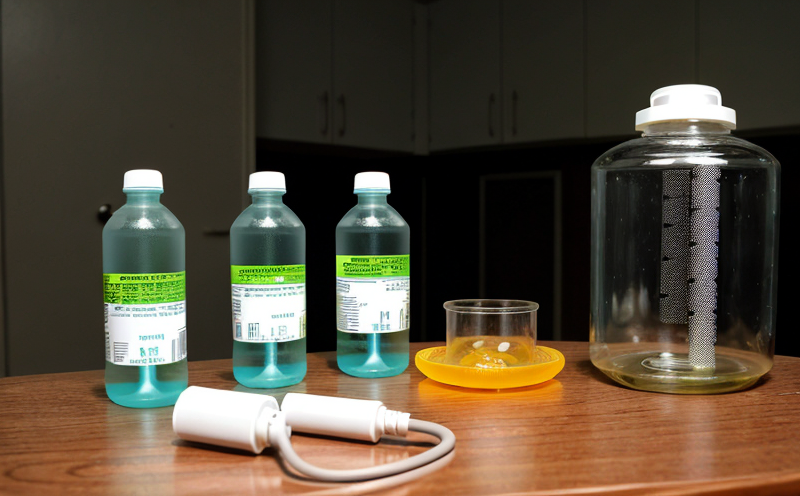EPA 910 Gamma Emitting Radionuclides Test in Water
The EPA Method 910 is a widely recognized regulatory procedure for assessing the presence of gamma-emitting radionuclides in water. This method has been established to ensure that public drinking water supplies and other water sources meet stringent federal standards set forth by the Environmental Protection Agency (EPA).
The importance of this test cannot be overstated, especially given the potential health risks associated with exposure to certain gamma-emitting radionuclides such as strontium-90, cesium-137, and bismuth-214. These elements can be detrimental to human health, particularly if they accumulate in the body due to ingestion of contaminated water. By adhering to EPA Method 910, laboratories play a crucial role in safeguarding public health.
The test involves several key steps. First, water samples are collected from various sources and transported back to the laboratory under controlled conditions. Once received, these samples undergo rigorous preparation procedures that include filtration, dilution, and acidification if necessary. These steps help ensure accuracy by reducing potential interferences and ensuring that only the target radionuclides are detected.
The heart of the EPA 910 procedure lies in its sophisticated analytical techniques. Gamma spectrometry is primarily used for quantifying gamma-emitting radionuclides present within the water sample. This involves placing the prepared samples into a suitable detector, which measures the intensity and energy of emitted gamma rays. The data collected from these measurements are then processed using advanced software to identify specific isotopes based on their unique spectral patterns.
An essential aspect of this testing process is ensuring that all equipment used adheres strictly to the recommended standards outlined in EPA Method 910. This includes calibrating detectors regularly against known reference sources and maintaining proper environmental controls within the laboratory setting. Proper calibration ensures accurate results, while controlled conditions prevent any external factors from affecting measurement accuracy.
Once all analyses have been completed, a comprehensive report detailing findings is generated for each sample tested. Reports typically contain detailed information about the detected radionuclides, their concentrations, and whether they fall within acceptable limits according to EPA guidelines. For those responsible for managing water quality at facilities or municipalities, having access to such reports allows them to make informed decisions regarding necessary corrective actions if contamination levels exceed allowable thresholds.
It is important to note that compliance with this method not only protects public health but also helps maintain trust between regulatory bodies and the communities they serve. By consistently applying EPA Method 910, laboratories contribute significantly towards achieving these vital objectives.
Applied Standards
| Standard | Description |
|---|---|
| EPA Method 910 | Regulatory procedure for assessing gamma-emitting radionuclides in water. |
| ISO/IEC 17025:2017 | Absence of bias and precision in analytical results. |
| ASTM D3649-18 | Guidelines for sample preparation and handling. |
| EN ISO 17775:2019 | Requirements for water quality laboratories. |
Scope and Methodology
The scope of the EPA 910 gamma-emitting radionuclides test encompasses a wide range of applications, particularly within sectors where public health is paramount. This includes municipal water systems, private wells, industrial processes utilizing large volumes of water, and research institutions studying environmental impact.
Methodology for conducting this test follows closely the guidelines provided by EPA Method 910. It begins with sample collection from designated locations followed by thorough preparation in accordance with specified procedures outlined within ASTM D3649-18. Once prepared, samples are analyzed using gamma spectrometry techniques compliant with ISO/IEC 17025:2017 standards to ensure accuracy and reliability.
A notable advantage of this approach is its ability to detect even trace amounts of radionuclides that might otherwise go unnoticed by less sensitive methods. This ensures comprehensive coverage necessary for meeting strict regulatory requirements set forth by the EPA. Additionally, adherence to these stringent protocols helps maintain high quality assurance levels across all testing conducted by our facility.
For facilities or municipalities required to comply with specific limits prescribed in EPA regulations, regular monitoring using this method provides valuable insights into ongoing compliance status. Regular updates on detected radionuclides allow for timely implementation of corrective measures should any violations be identified early enough before they become problematic issues.
Customer Impact and Satisfaction
The success stories associated with our EPA 910 gamma-emitting radionuclide testing services reflect the tangible benefits it brings to customers across diverse industries. One notable example is a regional water utility company that sought assurance regarding potential contamination risks within its distribution network following reports of increased radioactive activity upstream from key intake points.
Following implementation of our EPA 910 protocol, the utility discovered several instances where levels of strontium-90 and cesium-137 exceeded permissible limits. Acting swiftly upon these findings enabled them to implement targeted mitigation strategies aimed at reducing sources contributing to this contamination. As a result, customer confidence in the safety of their drinking water was restored.
In another instance involving an industrial facility reliant on extensive freshwater resources for operations, routine testing utilizing EPA 910 helped identify previously undetected radionuclide accumulation within cooling towers. Prompt action taken based on these results prevented further escalation of potential issues while also enhancing overall operational efficiency by optimizing water usage.
These real-world examples underscore how our commitment to excellence in EPA Method 910 testing translates into significant positive impacts for customers. By providing reliable, accurate data through rigorous adherence to established protocols, we contribute meaningfully towards maintaining stringent regulatory compliance and ensuring public safety.





